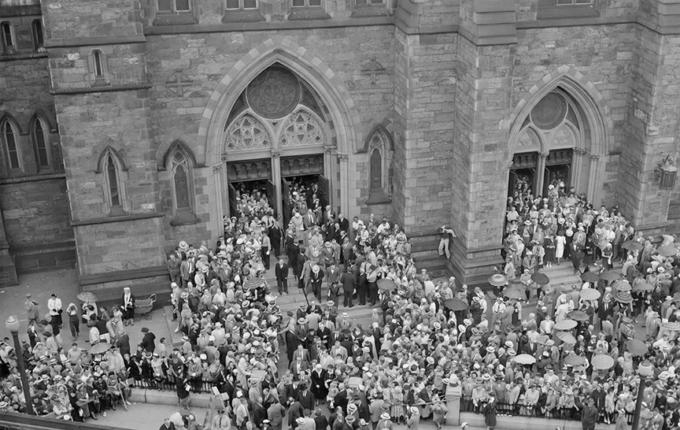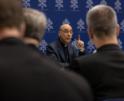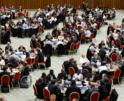
Culture

Bishop Fenwick himself escaped death by mere moments, the collapse occurring immediately after he led a procession from the back to the front of the church.
Some of the most beloved photographs held by the archives are those that show enormous crowds packed into Boston's Catholic churches in the mid-to-late 19th century. These are the photographs that are used to illustrate histories of the rise of Catholic Boston, city of immigrants. They are used as the visual representation of Cardinal William H. O'Connell's famous utterance, "The Puritan has passed. The Catholic remains."
The scenes depicted in these photographs, while beautiful, would fill modern fire marshals with trepidation. Worshippers fill pews, aisles, and choir lofts. They spill out of doorways, blocking entrances and exits. Outside, they line the streets, clogging sidewalks. These images are powerful witnesses to the passion and strength of Boston's Catholic community at the time, but they also serve as reminders of the perils of large gatherings in an era before legal crowd regulation.
On March 25, 1853, Bishop Bernard F. Fitzpatrick entered Holy Week with some unease. Overcrowding at the Cathedral of the Holy Cross during Holy Week, he wrote, "has caused some disorder and apprehension of accidents the last three years." To keep the crowds at bay, that year the bishop requested that a police presence be stationed at the cathedral on Good Friday. Police were "stationed at each door to keep off the crowd when the church is filled." With this added measure of security, the service proceeded "without confusion."
While the enthusiastic crowds that filled the cathedral during Holy Week in the early 1850s were noisy, no serious incidents were recorded in those years. Yet Bishop Fitzpatrick understood that with large crowds came risk. He feared the possibility of a large-scale accident or a stampede in the church, and his fears were not unfounded.
In 1834, Bishop Fitzpatrick's predecessor, Bishop Benedict J. Fenwick, had traveled to New Haven, Connecticut (then part of the Diocese of Boston), to dedicate the new church of St. John the Evangelist. The church had been built in less than a year to accommodate a congregation of about 200 Catholics. At the church's dedication, the congregation, along with many of their curious Protestant neighbors, crowded into the new church. They did not know that the church had been built with a major design flaw: its architect had failed to adequately support the 14-foot loft that jutted out above the church's main entrance. During the dedication, the loft gave way, unable to support the people who crowded onto it for a better view of the ceremony. It crashed down upon those gathered below.
The Boston Jesuit reported, "in an instant the whole assembled crowd; was thrown into a state of the most horrible confusion, where nothing was heard but the screams of the affrighted ... All self-possession was lost for some moments -- everyone imagined that the entire edifice was tumbling upon him. A rush was made to the sacristy ... while numbers climbed up and escaped through the windows." Six people were gravely injured, and there were two deaths, a boy named Abraham Bryan and his grandfather, a "Mr. Hardyear." Bishop Fenwick himself escaped death by mere moments, the collapse occurring immediately after he led a procession from the back to the front of the church.
In the wake of the disaster at New Haven, churches in New England began to take additional measures to cut back on crowds and ensure the safety of their Masses and events. In the archdiocese, tickets were issued for events anticipated to draw a large crowd, such as church dedications and anniversary Masses. As the bishop's journal demonstrates, police were also used to control crowd size and ensure that aisles and entrances were not blocked.
Church buildings were also constructed with additional safety features. When St. Mary's Church opened in Boston's North End in 1877, for example, The Pilot reported that it had "three large doors" and an additional "five other doors or entrances which can be used at a moment's notice in case of fire, or a stampede of the congregation." An incident that occurred in Providence, Rhode Island, the year after St. Mary's was dedicated demonstrates the wisdom of St. Mary's architects.
In 1878, The Pilot reported on a harrowing incident that took place during Holy Thursday Mass at the Cathedral of Sts. Peter and Paul in Providence. The cathedral was "crowded to the utmost capacity... when suddenly a woman took fright at some noise overhead in the east wing of the church and impulsively cried out." Those near her became alarmed, "and rushed from their seats in great consternation through the aisles for the doors. The alarm spread instantly... and quicker than it takes to tell it the whole congregation was on their feet in uproar and confusion."
Only the quick thinking of Providence's Bishop, Thomas F. Hendricken, prevented a tragedy from unfolding. Rushing to the center of the sanctuary, he bellowed, "Kneel down at once where you are; there is no occasion for alarm." Calm was restored and no one was killed or injured that day.
In the 20th century, in New England and across the country, building capacity laws and fire codes were strengthened to combat accidents and near-accidents related to overcrowding. These codes ensure that all Holy Week Masses -- indeed, all Masses -- will proceed like the one in 1853, "without confusion."
VIOLET HURST IS AN ARCHIVIST FOR THE ARCHDIOCESE OF BOSTON.
Recent articles in the Culture & Events section
-
'Dignitas' and the mediaRussell Shaw
-
Scripture Reflection for April 14, 2024, Third Sunday of EasterDeacon Greg Kandra
-
St. Helena's House is established in the South EndThomas Lester
-
Is this synodality?Russell Shaw
-
Poking the hornet's nest of IVFFather Tadeusz Pacholczyk


















